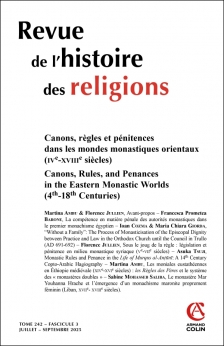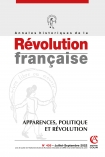
REVUE DE L'HISTOIRE DES RELIGIONS (3/2025)
Pour acheter ce numéro, contactez-nous
Recevez les numéros de l'année en cours et accédez à l'intégralité des articles en ligne.
Il existe en milieu syriaque plusieurs collections de législations monastiques, d’origine syro-orientale ou occidentale, rédigées en milieu romain ou perse. Ces textes normatifs sont les vestiges d’un matériau certainement plus important. Certains furent mis par écrit après un long temps d’expérience ascétique : ce processus rédactionnel s’inscrit dans une nécessité de codification et de réajustement de l’agir personnel et communautaire. En examinant l’exemple de la règle d’Abraham de Kaškar rédigée en 571 en Mésopotamie du Nord, nous montrerons comment un « laboratoire communautaire » en est venu à formuler l’interdit et à appliquer un usage pénal pour protéger la vie commune au quotidien, mais aussi comment la règle fut mise au service d’une identité christologique.
Several collections of monastic legislation are known in Syriac: East and West Syrian rules, written in the Eastern Roman or Persian environment. These normative texts are what remains of a larger body of writings that has in large part been lost, and which must be considered in its context of production as a whole, albeit a heterogeneous one. Certain pieces of monastic legislation were written down after a long period of ascetic experience: this process of composition arose from the need to codify and readjust both individual and community actions. By examining the example of the rule of Abraham of Kaškar, written in 571 at the Great Monastery on Mount Izla, Northern Mesopotamia, we show how a “community laboratory” came to formulate these prohibitions and apply a penal practice aimed at protecting daily life within the community. We also show how the rule was first of all a means of preserving a Christological identity.

